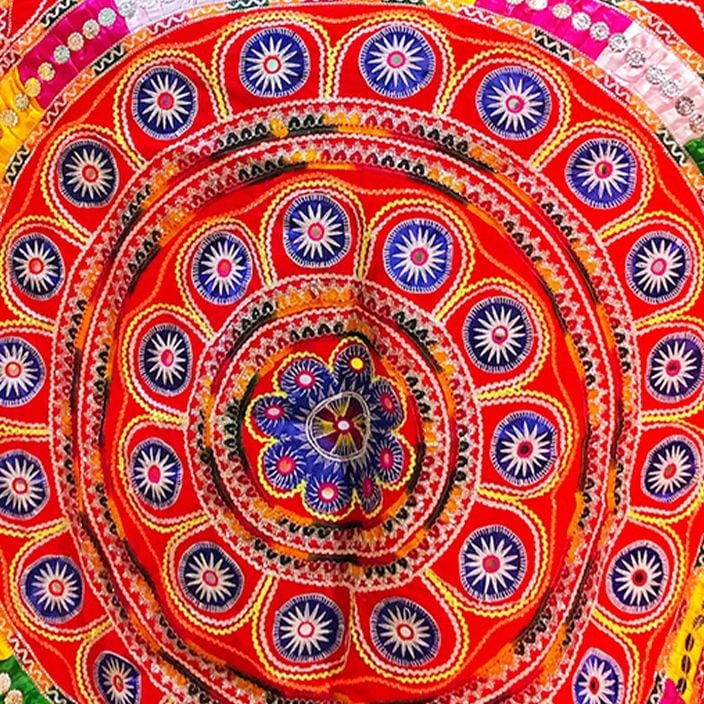For best prices and early deliveries, WhatsApp us at. 918488070070

Applique Work
In some way or the other, we have been familiar with appliqué work – be it on our childhood frocks and bibs, our mother and grandmother's sarees, or even as beautiful patterns made on vintage table wears and upholstery. Applique work has stood the test of time and made an impression on various textiles, from clothing to furniture. This sewing technique is famous for its abstract shapes and cuts and scrapes of fabrics sewn into a larger piece of fabric to create patterns. In Odhisha, this technique was Conventionally a part of the rituals of Lord Jagannath – the most significant and relevant God of the people of this region. Applique work was used to make canopies, umbrellas, and fans (known as trasa), used in pujas and festivals in Puri's famous temples.
Tracing Its History
Applique work has a long-standing history, and its path waves throughout the world, from Africa to the regions of Sindh, Pakistan. So it is fair to say that no single place can be pointed out as its soul place of origin.
So, the question that most evidently arises is- How is the history of this world-famous art form connected to the state of Odisha? Also known as Chandua, applique work's history can be traced back to the 12th century, from the small village of Pipli in the Puri district. This sewing technique came into existence when clothes got ripped and needed instant fixing. Slowly, the people started adapting it and adding creativity to it to the extent that this style reached its peak of excellence and was then appreciated by the Kings and royalties.
In ancient Odhisha, appliqué work became a luxury used in the most auspicious and important festivals, especially to decorate Lord Jagganath's chariot. With such vast usage of the art form, soon it became the primary source of income for the handicrafts community in the entire state.
How It's Made
Not similar to the other forms of art out there, applique work was rather a pleasant accident that took place when harsh financial times forced people to fix torn clothes. They used pieces of small cut fabrics
to sew onto the rip to hide it, and before anyone knew it, this technique became a real art form!
Significance and Symbolism
The art form of Applique became so distinct and popular with time that its identity became a soul aspect of the small village of Pipli, and it came to be known as "Pipli Art." Its origin, dating back to the 12th century, appliqué work became a part of the core tradition of this region. Used in ancient rituals by the Maharajas and their Purohits, as offerings and decorations to Lord Jagganath, appliqué art has been historically and culturally significant.
Traditionally, Pipli art featured beautiful elements of nature, mythology, and folklore famous in the region. These include the face of Lord Jagannath himself, flowers and trees, and animals like peacocks and elephants.
Variations of the Craft
Applique work is done mainly in two ways. The first and conventional way is to sew small cut pieces of fabric on a larger canvas to obtain the desired shape. The other way of doing it is by laying two fabrics above the other and cutting the desired shape on the top layer to expose the one at the bottom.
Commonly used fabrics used for appliqué are cotton, velvet, and swede. But with time, different types of fabrics are incorporated into this art form.
Design Elements
Small abstract patterns are cut out of different fabrics and then sewn together to form shapes and figures in desired colors. Further embellishments like mirror work and embroidery are used to add more depth.
Applique Work Today
Historical uses of the art were mainly limited to objects used in rituals and pujas. But with the demands of modern times, it had to be incorporated into more things to keep the craft alive. As a result, you can see variations of applique work on bags, dresses, and even quirky jewellery.
Though the utilization of this art form has decreased now, it remains one of the most ancient forms of handicraft that contrasts today's fast-fashion world.
Applique work is a decorative needlework technique that involves attaching small pieces of fabric onto a larger fabric surface to create a design, and it is often combined with other forms of embroidery such as kasuti embroidery and berhampuri patta to enhance the overall visual appeal of the piece.
Image Credits
Craffi | D'Source | Flickr | Gaon Connection | Odisha | Quirky Wanderer | Telegraph India | The Cultural Heritage of India | India Mart